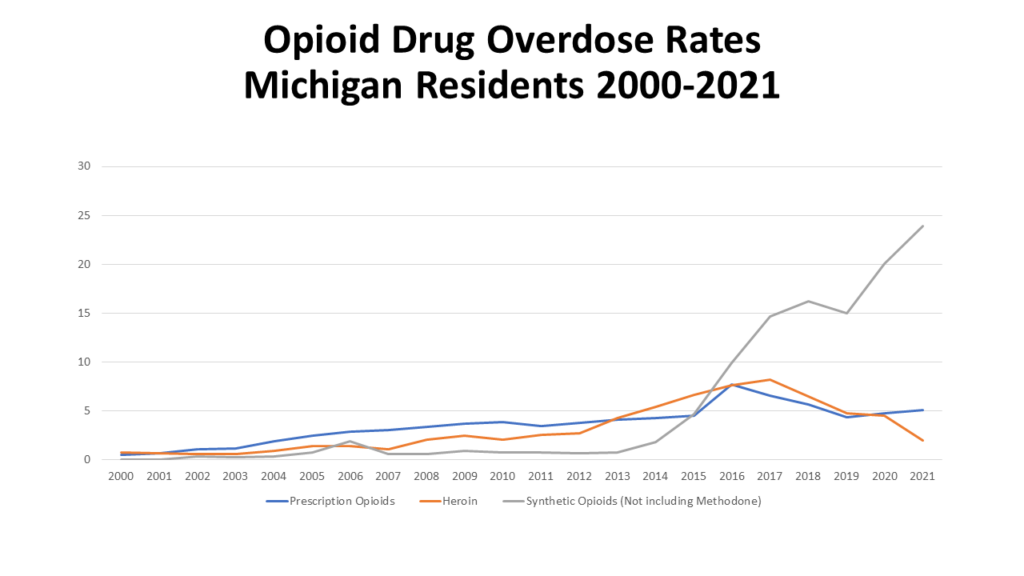Michigan’s opioid epidemic is no secret, and it is not just prescription pills that are contributing to the rise in overdoses. Opioids include prescription pain relievers such as oxycodone (Oxycontin), hydrocodone (Vicodin), codeine, morphine, fentanyl, methadone, and the illegal drug heroin. However, pain killers that are not prescribed or are used outside of the prescription are considered illegal. Furthermore, pain killers such as fentanyl are being illegally manufactured and distributed at an increasing rate. As the first chart below shows, the number of overdose deaths for all opioids has increased since 2000, but synthetic opioid overdose deaths have risen the most over the last several years, according to data from the Michigan Department of Health and Human Services.
In 2000 there were 17 synthetic opioid overdose deaths (not including methadone) in the State of Michigan. Comparably there were 60 prescription opioid overdose deaths in Michigan in 2000 and 89 heroin overdose deaths. In 2021 there were 2,287 synthetic opioid overdose deaths, 512 prescription opioid overdose deaths and 145 heroin overdose deaths. In Michigan, synthetic opioid overdose deaths increased the most between 2014 and 2015 and 2019 and 2020. Between 2014 and 2015 synthetic opioid overdose deaths increased by 465 deaths, from 175 overdose deaths to 465 overdose deaths. Between 2019 and 2020 opioid overdose deaths increased by 466, from 1,445 to 1,911. Although heroin and prescription overdose deaths have also increased since 2000, the number of overdose deaths for both categories have not grown by the amounts that synthetic opioid overdoses have, nor have they reached (individually) as high an overdose death number as synthetic opioid overdose deaths.
The yellow line in the chart represents the total number of opioid overdose deaths between 2000 and 2021, as reported by the Michigan Department of Health and Human Services. The yellow line often falls below the total number of opioid overdose deaths calculated when combining prescription and synthetic opioids and heroin. According to the Michigan Department of Health and Human Services, the summing of categories will not always result in more than the number of all opioid drug overdoses and the categories of death are not exclusive as deaths might involve more than one drug.
It is also important to note that prescription overdoses includes both prescription opioid pain relievers (e.g., hydrocodone, oxycodone, and morphine) and opioids used to treat addiction (e.g., methadone)

The first chart shows the sheer number of opioid overdose deaths by category, and the chart below shows the rate of opioid overdoses by category, again highlighting the increase in synthetic opioid overdoses. The rates below are calculated per 100,000 people. Prescription opioids regularly had the highest overdose mortality rate up until 2015. In 2015 the overdose mortality rate for prescription opioids was 4.5 overdoses per 100,000 people and for synthetic opioids the rate was 4.7. From there, the overdose rate for synthetic opioids grew to a rate of 23.9 overdose deaths per 100,000 in 2021. Prescription opioid overdose rates and heroin overdose rates also grew for a few years beyond 2015, both peaking after then. The prescription opioid overdose rate peaked in 2016 at 7.7 and the heroin overdose rate peaked at a rate of 8.2 overdoses per 100,000 in 2017. Overdose rates for prescription opioid overdoses and heroin overdoses have decreased since then.

The data clearly shows opioid overdoses continue to increase in Michigan, and synthetic opioid (such as fentanyl) overdoses are playing a large role in that. An obvious question may be, why fentanyl? Well, fentanyl is a highly potent opioid that only requires people to ingest a tiny amount to overdose.
According to Rutgers University, in many areas, fentanyl has nearly completely replaced heroin and can be found in many counterfeit prescription opioid and benzodiazepine pills bought on the street. Methamphetamine and cocaine may also contain undeclared fentanyl.
As shown, Michigan is not immune to its population gaining access to this highly dangerous drug. And while it is still found on the streets, law enforcement agents are working to stop production and distribution. According to the US Department of Justice, more than 65 kilograms of fentanyl powder and 88,000 fentanyl laced pills were seized by federal agents during May 23 and Sept. 8, 2022. The USDOJ said this was enough to provide 4.7 million deadly dosages.
According to the USDOJ, fentanyl is 50 times more potent than heroin. Just two milligrams of fentanyl, or the amount that could fit on the tip of a pencil, is considered a potentially lethal dose.
The risk of overdose remains high with opioid use, as do other negative consequences from using opioids. So, while law enforcement officials work to eliminate illegal production, distribution and use of opioids there are also organizations working to help those with an opioid addiction. As we have noted throughout this series, to end the opioid epidemic we need a multi-faceted approach and treating addiction is part of that approach. In our next post we will discuss these programs and their impacts.


